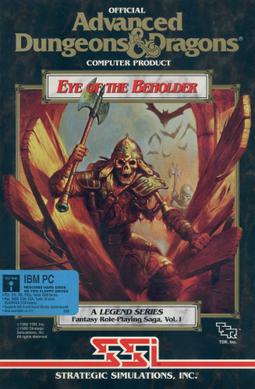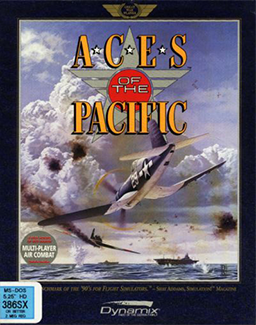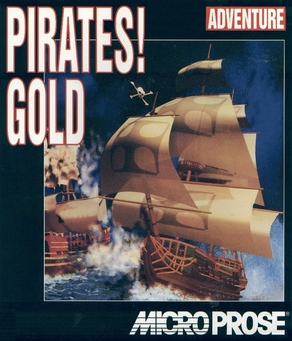
Day of the Tentacle, also known as Maniac Mansion II: Day of the Tentacle, is a 1993 graphic adventure game developed and published by LucasArts. It is the sequel to the 1987 game Maniac Mansion. The plot follows Bernard Bernoulli and his friends Hoagie and Laverne as they attempt to stop the evil Purple Tentacle - a sentient, disembodied tentacle - from taking over the world. The player takes control of the trio and solves puzzles while using time travel to explore different periods of history.

Eye of the Beholder is a role-playing video game for personal computers and video game consoles developed by Westwood Associates. It was published by Strategic Simulations, Inc. in 1991, for the MS-DOS operating system and later ported to the Amiga, the Sega CD and the SNES. The Sega CD version features a soundtrack composed by Yuzo Koshiro and Motohiro Kawashima. A port to the Atari Lynx handheld was developed by NuFX in 1993, but was not released. In 2002, an adaptation of the same name was developed by Pronto Games for the Game Boy Advance.

Abrams Battle Tank is a video game developed by Dynamix and published by Electronic Arts in 1988 for MS-DOS. Designed by Damon Slye, the game is a 3D vehicle simulation of the M1 Abrams tank. The 1991 Sega Genesis port by Realtime Games Software was renamed to M-1 Abrams Battle Tank.

The Incredible Machine (TIM) is a series of video games in which players create a series of Rube Goldberg devices. They were originally designed and coded by Kevin Ryan and produced by Jeff Tunnell, the now-defunct Jeff Tunnell Productions, and published by Dynamix; the 1993 through 1995 versions had the same development team, but the later 2000–2001 games have different designers. All versions were published by Sierra Entertainment. The entire series and intellectual property were acquired by Jeff Tunnell-founded PushButton Labs in October 2009. PushButton Labs was later acquired by Playdom, itself a division of Disney Interactive, so as of now the rights are held by The Walt Disney Company.

Sid Meier's Pirates! is a video game created by Sid Meier for the Commodore 64 and published by MicroProse in May 1987. It was the first game to include the name "Sid Meier" in its title as an effort by MicroProse to attract fans of Meier's earlier games, most of which were combat vehicle simulation video games. The game is a simulation of the life of a pirate, a privateer, or a pirate hunter in the 16th, 17th and 18th centuries. It was widely ported to other systems.

Red Baron is a combat flight simulation video game for MS-DOS created by Damon Slye at Dynamix. It was published by Sierra On-Line in 1990. The game was ported for Amiga and Macintosh computers in 1992.

Gobliiins is a puzzle adventure video game series, consisting of five entries, released by Coktel Vision for the Amiga, Atari ST, DOS, and Macintosh platforms. The first three titles were released in the early 1990s, the fourth in 2009. The visual look of the series and its characters were created by French artist Pierre Gilhodes, whose style was used in another game from Coktel Vision: Woodruff and the Schnibble of Azimuth.
Dynamix, Inc. was an American developer of video games from 1984 to 2001, best known for the flight simulator Red Baron, the puzzle game The Incredible Machine, the Front Page Sports series, Betrayal at Krondor, and the online multiplayer game Tribes.
Appaloosa Interactive was a corporation, founded in 1982 in Hungary, that produced video games, computer programs and television commercials during the 1980s and 1990s.

Rise of the Dragon, released in 1990 by Dynamix, marks the company's venture into the cyberpunk genre, distinct from its usual portfolio of action and flight simulators. This graphic adventure game is set in a future dystopian version of Los Angeles, circa 2053, and follows the story of detective William 'Blade' Hunter as he investigates the death of the mayor's daughter, linked to a dangerous new drug, MTZ. The gameplay combines detective work, strategy, and action. Players must solve puzzles that influence the storyline, interact with characters who remember past choices, and tackle action sequences. If players fail these sequences multiple times, the game may offer to automatically complete them.
Jeffrey Tunnell is a video game producer, programmer and designer.

Aces of the Pacific is a combat flight simulation game developed by Dynamix for MS-DOS compatible operating systems and published by Sierra On-Line in 1992. The game takes place during World War II. Players can choose a single mission or a career path in United States Army Air Forces, United States Navy, United States Marines, Imperial Japanese Army, or Imperial Japanese Navy. Dynamix followed-up the game with Aces Over Europe in 1993.

The Incredible Toon Machine is a game from Sierra On-Line, and is the sequel to Sid & Al's Incredible Toons, also from Sierra. The game is a Windows port of Sid & Al's Incredible Toons with added multimedia features such as animated cut scenes between levels and CD music tracks.

Heart of China is a 1991 adventure game developed by Dynamix and published by Sierra On-Line. The game follows the exploits of pilot Jake "Lucky" Masters as he tries to rescue nurse Kate Lomax from a ruthless Chinese warlord.

Arthur to Astaroth no Nazomakaimura: Incredible Toons is a 1996 puzzle video game for the Sega Saturn and PlayStation which was only released in Japan. Capcom licensed Dynamix's Sid & Al's Incredible Toons engine with a Ghosts 'n Goblins motif, so it is essentially a sequel to that game. The game was initially completed without the Ghosts 'n Goblins characters, which Capcom decided to add in at the last minute.

Arcticfox is a science fiction tank simulation video game developed by Dynamix and published by Electronic Arts in 1986. It was published in Europe by Ariolasoft. A sequel to Dynamix's Stellar 7, the Atari ST, Commodore 64, ZX Spectrum, MS-DOS, and Apple II. A third game was released in the series in 1991 titled Nova 9: The Return of Gir Draxon.

Pirates! Gold is a 1993 computer game, a remake to Sid Meier's 1987 release, Sid Meier's Pirates!

The Incredible Machine 2 is a video game released in 1994 for DOS, and part of The Incredible Machine video game series. The Incredible Machine Version 3.0 was released in 1995 for Mac OS and Windows containing the same levels as The Incredible Machine 2, but with an improved interface and added extra features like CD music tracks. Re-releases of the series, including the 2009 compilation The Incredible Machine Mega Pack, have included Version 3.0.

Knights of the Sky is a World War I combat flight simulator designed by Jeff Briggs and published by MicroProse in 1990 for MS-DOS. Ports to the Amiga and Atari ST followed in 1991.

The Incredible Machine is a puzzle video game released in 1993, and the first release in The Incredible Machine video game series. The objective of the game is to create Rube Goldberg machines by arranging collections of objects in a complex fashion, so as to perform some simple task. The Even More Incredible Machine was an extended version of the original, also released in 1993; it had 160 levels, about twice the number of levels in the original game, and had more parts to use in the contraptions.

















